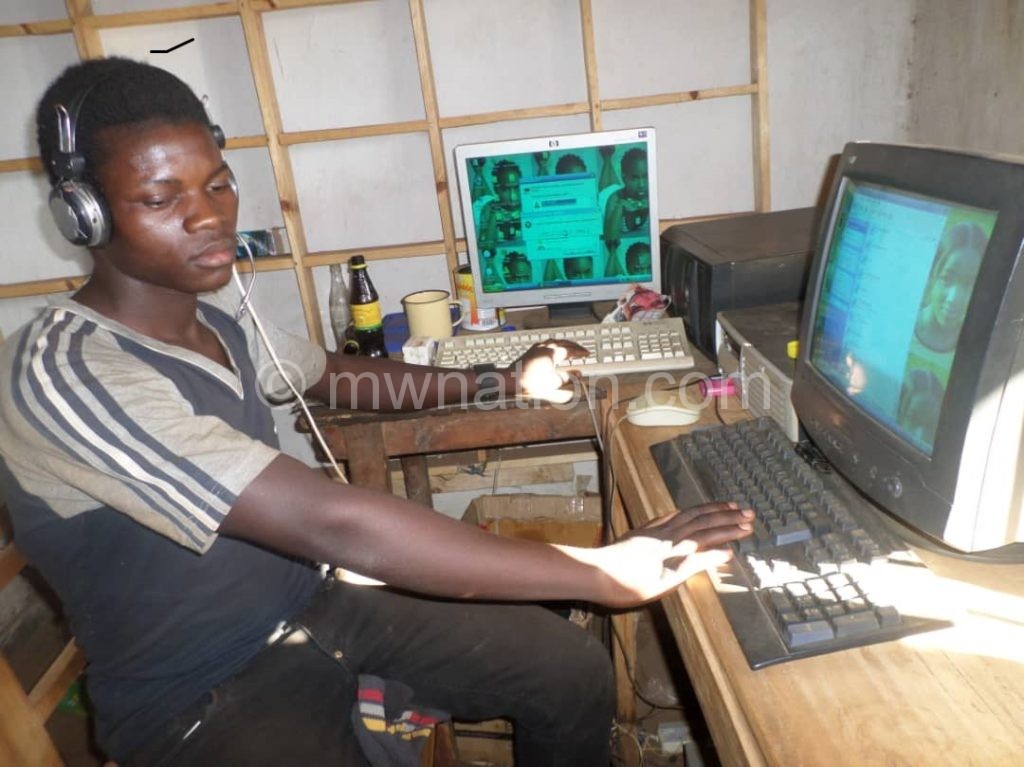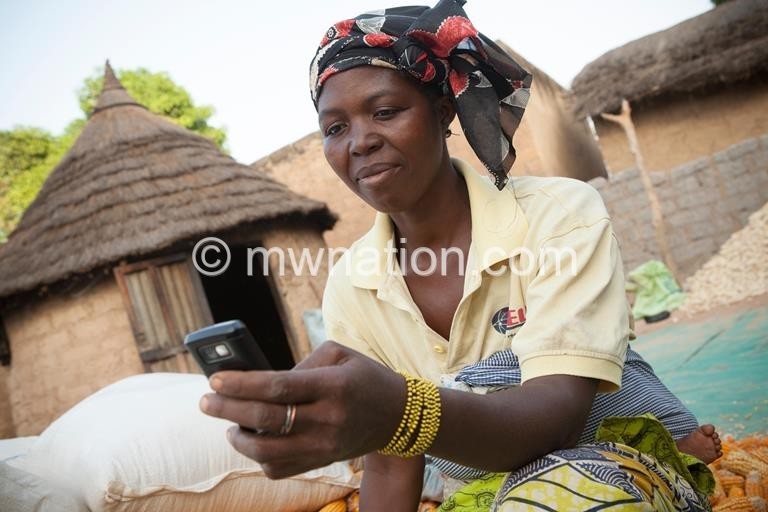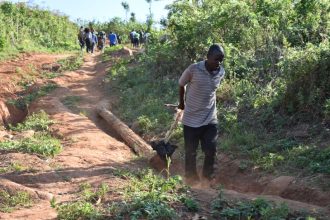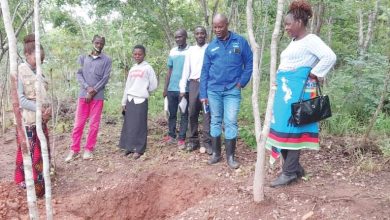Bridging extension gap with videos
For close to a decade, Phemiya Mpombwe has been farming rice in Chiumbuzo Village in T/A Kaduya’s area in Phalombe. Yet, it is in the last three years that she has seen her yield rise drastically.
Previously, Mpombwe said she used to harvest 70 bags. But today, on the same plot, she harvests 160 bags.

“Previously, I was just planting anyhow. Today, I plant rice 17 centimetres apart in a straight line. We use a rope with knots at the 17-centimetre intervals for the planting stations. I am glad I followed the guidance I got,” she says.
At the end of the day, the grains are far much healthier. On the other hand, she adds, weeding her paddy is no much of a problem.
In a country with an extremely low number of extension workers, Mpombwe owes her success to a video she saw on how to plant rice effectively. “One of the boys who has a video showroom sold me a video showing the proper way to plant rice. Here I am. More harvest means more money and an end to some of my problems,” she adds.

Lester Mpinda of Mwanza has his own tale. From a small farmer selling chillies in his locality at K40 a kilogramme (kg), he has grown to selling at about K2 500 per kg in other areas through the National Smallholder Farmers Association of Malawi (Nasfam). That is more or less twice the price of Malawi’s major forex earner, tobacco.
“It rooted from watching a video which I got from the Khuyabwe Telecentre in 2015 on proper chilli growing. I later got some seed from Nasfam and shared it with fellow farmers. We established a club with 12 members.
“I invited each of the members once or twice a week to watch the videos on the proper husbandry practices. We have grown our reach beyond Mwanza through Nasfam which buys our produce,” says Mpinda.
Through the videos, Mpinda further says he has learned diversification, not to rely on one crop. He also grows rice and vegetables which his wife sells at a local stall.
“I have learned a lot from taking care of nursery beds, to transplanting and harvesting,” he says.
Today, he features in one of the videos on how to grow chillies. The club has grown to a membership of 80.
Mpombwe and Mpinda are two of close to 100 000 farmers who stand to benefit from extension offered through videos produced by Access Agriculture in corroboration with Nasfam. It partners with the Farm Radio Trust, Channel for All Nations, Chanco TV, Luntha TV, which have free access to air the videos.
It also partners with Feed the Future, the Catholic Relief Services (CRS) and the Ministry of Agriculture, Irrigation and Water Development. This emanates from a memorandum of understanding with the Malawi Forum for Agricultural Advisory Services (MaFAAS), a platform for strengthening agricultural extension and advisory service through information-sharing and action for professionalism, standardisation and quality assurance.
The videos are shared on the Access Agriculture’s website and are also distributed via WhatsApp and burning centres.
Silaji Fanuel operates a burning centre at Mangochi turn-off. He says willing farmers pay K50 for each video.
“This is working as people are able to watch the videos on their phones, computers and even TV sets. We upload the videos that are coming in different formats and sizes,” says Fanuel.
Statistics from the Civil Society Agriculture Network (Cisanet) indicate that one extension worker in Malawi services between 1 500 and 3 900 farmers. This, in turn has left farmers not getting proper husbandry practices, which in turn leads to low yields.
According to a policy brief on the implementation of the 2012/13 Farm Input Subsidy Programme (Fisp), co-authored by Ephraim Chirwa and Andrew Dorward, only 11 percent of farmers received advice from field assistants in 2012/13, compared to 22 percent in 2006/07 and 14 percent in 2008 and 2011 agricultural seasons.
Moreover, even though the research shows that access to extension services is significant in explaining productivity levels of both female and male-headed households, the 2013 Integrated Household Survey (IHS) analysis shows that access to extension services is biased against some segment of the farming population.
Over the past decades, Malawi has undergone several reforms in its agricultural extension system— from the master-farmer scheme and the achikumbi or progressive farmer approach of the 1950s and 60s to farmer groups in 1970s to the training and visit system in the 1980s, to, more recently, the passage of national extension policy in 2000 which emphasises that farmers demand stakeholder accountability, pluralism, coordination and quality in agricultural services provision.
Government also embarked on recommitment programme, albeit on pilot phase, in which Malawi School Certificate of Education holders underwent on-the-job training programme at the Natural Resources College in a bid to overcome the challenge of unwillingness by some extension workers to work and live in rural areas.
But the journey continues because, despite such efforts, surveys indicate that more needs to be done. For example, the 2013 IHS indicates that 27 percent of farming households reported accessing extension services through direct contact with government extension agents, six percent through NGOs with only 2 percent receiving advice from the private sector.
Nasfam communications manager Vincent Nhlema says the videos are effective in extension work. In his words, it beats radio and written services.
“Videos show reality. Before producing the videos, we find practising farmers so that they show what is really working. We work hand in hand with the agriculture ministry so that the message we preach should confirm with government policies,” says Nhlema.
He says that apart from producing videos from local farmers and extension workers, they also translate others from abroad. This helps Malawian farmers to replicate what is working in other countries.
According to Ronald Kondwani Udedi, Access Agriculture’s Southern African representative, the videos are in Tumbuka, Sena, Yao and Chichewa. Currently, there are over 200 videos on different topics in 72 African languages.
“We promote the use of farmer-to-farmer videos to bridge the gap. This speeds up the process of reaching out to farmers. Farmers are able to watch the videos even from the cheapest of phones,” he observes.
As some of the success stories, he cites the Zikometso Cooperative bird eye chilli farmers in Mulanje, Mwanza pigeon pea farmers who turned around their fortunes after watching the videos.
“The topics are very diverse for the benefit of the farmers. From proper practices in the field, we have slots on value addition, resource management and village savings and loans. As a matter of fact, some of the video operators stand to benefit as well,” said Udedi, who represents Access Agriculture in Zambia, Mozambique, Malawi and Zimbabwe.
Osman Majid, who owns a burning centre at Nathenje in Lilongwe, recently won the organisation’s Young Entrepreneurship Challenge Fund. He is one of the six recipients of smart projectors in Africa.
“I have been uploading the videos in people’s phones for sometime. We were asked to say what we would do with the smart projectors and my entry won. The projectors will help me to go and show the videos for a fee in the remote areas around the vicinity. Some of the farmers don’t have phones so reaching out to them with the smart projector,” says the 19-year-old.
According to the ICT Works website, facilitated video viewing, as championed by Access Agriculture, can spur farmers to adopt new agricultural practices for about one-tenth of the cost of traditional extension systems.
The organisation says much of the success of facilitated video stems from its ability to demonstrate localisation. Farmers featured in the videos are usually from the same district as the viewers, and because the videos are shot in the farmers’ own fields, the viewers can compare the conditions in the videos to those in their own fields. This builds trust in the information shared.
As the smallest of specks is seen on snow, Nhlema says poverty could hamper the good efforts in some areas.
“Not all farmers have access to phones and the Internet. Apart from that, we have a low uptake of electricity in the country, which means a good number of the farmers are not able to watch the videos. Otherwise, this is one sure way that we can save on fuel since extension workers will not have to go on the ground meeting farmers,” he says. n





